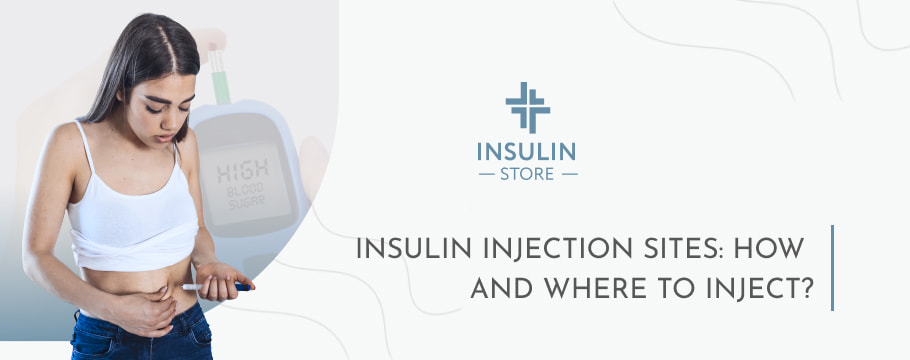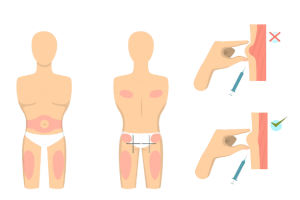
Insulin Injection Sites: How and Where to Inject?
Diabetes mellitus is one of the most widespread diseases on the Earth, with more and more people getting the needed dose of insulin hormone with the help of injections. Insulin is a prescription medicine prescribed by a doctor who has to teach the patient the correct insulin injection technique.
As people with diabetes need regular injections of insulin depending on the type of medication they are prescribed (short-acting or long-acting insulin), they need to do injections at least once each day, and most have to inject insulin on their own. That’s why it is crucial to learn all the nuances of injection insulin as wrong administration may be health- and even life-threatening.
How to Inject Insulin Correctly? Insulin Injection Techniques
There is nothing especially complicated about the technique of injection of this type of medication. However, there are a few moments to remember, as neglecting these nuances may cause inflammation, infection, swelling, sepsis, or other unpleasant and more serious complications.
First of all, always check the expiration date of the drug and strictly mind the storage conditions that are indicated on the package. Most insulin medications, if unopened, have to be stored in the fridge. In no way you can use the insulin vial that has been stored in the freezer or frozen. Opened vials have to be kept at room temperature in a dark place, far from the reach of direct sunlight.
If all the conditions are followed, you can proceed directly to the injection. Use just the size of the syringe and needle indicated in the instructions and strictly follow the dosage recommendations from the doctor. You should be aware that the patients themselves cannot change the insulin dose. It can lead to hypoglycemia (low blood sugar) and be life-threatening.
The administration of insulin is performed into the subcutaneous skin layer. Be careful to do not inject insulin intramuscularly or intravenously. This leads to the too rapid absorption of the substance and sharp jumps in glucose levels in the circulatory system. After the injection, do not touch, massage, or rub the skin to avoid infection and inflammation.
Recently, such devices as an insulin pen and a more advanced insulin pump have become more and more popular to control blood sugar and make the administering of the hormone easier and, in the case with the insulin pump, automatic.
Injection Sites for Administering Insulin
There are not so many areas on the body where you can inject your insulin. These are a few insulin injection sites:
- upper front abdomen: about 1 cm below the last rib, 1 cm away from the navel;
- the middle third of the outer part of the shoulder;
- the front upper surface of the thigh (the third closest to the groin);
- the upper part of the buttocks;
- the base of the scapula, to the right or left of the spinal column.
If you do insulin injections on your own, it is not recommended to inject the drug into the arm as it is not comfortable, and you can even unintentionally violate the technique of injection.
Also, the lack of fat tissue on the shoulders and thighs of children, adolescents, and thin people also will not make these areas perfect for insulin therapy.
Dependence of Hormone Absorption on the Insulin Injections Site
This is actually an interesting question. Does the insulin absorption depend on the place of injection, or the body absorbs insulin equally respectively of the injection site? The answer is – yes, it matters and a lot!
To prove this, we will provide you with the comparison information of absorption of insulin injected into various body parts, paying attention to the following aspects: effectiveness and speed of absorption.
Thus, the leader of the chart is the abdomen with 90% of effectiveness and the highest speed of absorption. Shoulder – 70% effective and quite fast absorption rate. Hip – 70% effective and slower absorption rate. Insulin administered in the sign is absorbed with 70% effectiveness and slowly. Finally, the scapula or shoulder blade possesses the lowest absorption effectiveness and speed among all areas of the body – just around 30%.
Short-acting insulin medications are the best to administer into the abdomen, while long-acting insulin should be injected into the thigh.
Should I Switch the Insulin Injection Sites?
We have found out that the abdomen is the best place to take insulin. However, it does not mean it is safe to do the injections always into the same site.
Actually, you should regularly rotate injection sites, and this is why. If you constantly inject the drug at one point, the subcutaneous body fat layer will be damaged. Seals (lipohypertrophy) will form in it, which significantly impair the efficiency of drug absorption. This rule is the same for insulin syringes and insulin pen devices.
You should retreat at a distance of at least 1.5-2 cm from the previous injection site and also regularly alternately do the injections into the arm, abdomen, and thighs. The alternation must be consistent to ensure a stable level of glucose in the bloodstream. You can “return” to the place of the last injection no earlier than three days later.
The Bottom Line
The level of compensation in type 1 diabetes depends not only on adherence to diet, correct dose, and medication schedule but on how competently the necessary procedures are carried out. The patient and his/her relatives should master the technique of correct insulin administration as soon as possible – this will significantly improve the patient’s quality of life.
Diabetes care should be taken very seriously as if you do not follow the injection recommendations, you may acquire many other health problems, skin diseases, irritation, inflammation, etc., that will worsen the situation.
Nowadays, the market offers more advanced injection options like pumps and pens with thin and comfortable pen needles for easier and painless administration of the hormone to regulate blood sugar. Nevertheless, people with diabetes should study trustworthy health information on insulin administration as their health and life may depend on it!
